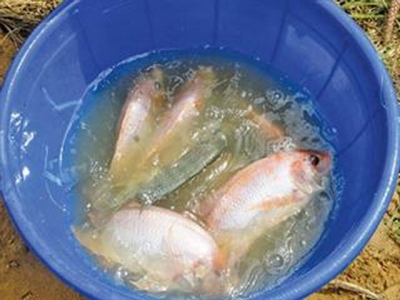The history of the red tilapia

Deep-bodied, fast-growing strains of red Mozambique tilapia are becoming the species of choice in regions where winter temperatures do not usually favour tilapia farming.
Red Nile tilapia are often paler in colour than our local red strain. Photo: Nicolas James
Back in the mid-1980s, a red or, more correctly, orange strain of tilapia began appearing in the aquaculture industry. It was immediately seen as an attractive food-fish option due to its close resemblance to popular marine species such as red roman or red snapper. Research indicates the Mozambique tilapia (Oreochromis mossambicus), our blue kurper, is the species most likely to exhibit this red colour trait, either totally or partially, although red Tilapia rendalli have also been reported.
These fish are near-albino or ‘xanthic’ – an absence of melanin in the skin allows the blood vessels to show through, but the eyes remain pigmented. Any form of albinism usually results in a degree of weakness in the animal, and inbreeding near-albino fish to produce a ‘red strain’ gives rise to ‘inbreeding depression’. This genetic condition is caused by breeding from a limited gene pool, and results in a reduction in general health.
This was obvious in the early forms of red tilapia; they were inbred and weak, and performed poorly in the aquaculture environment. Many of the red tilapia found in the local aquarium trade and aquaculture industry are still at this inbred stage. Several colour forms are available, some being almost white, others deep orange. Brother-sister breeding exacerbates the problem, and strains of unknown, undocumented ancestry should be avoided.
This weakness is, of course, not noticeable when fingerlings are purchased, as most look the same. The problem manifests itself as the fish grow – revealing themselves as large-headed, small-bodied specimens of little value. In the Far East, xanthic O. mossambicus were crossed with Nile tilapia to produce a hybrid strain with improved aquaculture potential: a deeper body-shape, later maturity, a smaller head and faster growth potential.
In South Africa, red O. mossambicus have been crossed with one of the best-performing strains of wild O. mossambicus to diversify their genetic make-up. This crossing and back-crossing does not lead to a hybrid, as only O. mossambicus is involved, and no conservation threat exists. These red tilapia are still pure O. mossambicus, and the best strain, now out-crossed and back-crossed five times over seven years, is marketed as the ‘Red 5’ strain.
The ideal combination?
This local strain has two advantages. Crossing the red tilapia with naturally occurring cold-tolerant populations passes on a degree of cold tolerance not present in Nile tilapia. Research shows that Nile tilapia only have an advantage over Mozambique tilapia at higher temperatures (25°C to 32°C), whereas the latter grow well at temperatures as low as 18°C to 25°C. Also, the high salinity tolerance of Mozambique tilapia allows for its culture in brackish or even full-strength seawater, something the Nile tilapia cannot tolerate.
Deep-bodied, fast-growing strains of red Mozambique tilapia available for aquaculture in indoor or tunnel-based operations are becoming the species of choice for recirculating aquaculture systems where winter temperatures are lower than optimum.
Có thể bạn quan tâm
 Which design is best?
Which design is best? The design of an aquaculture system is essential to the operation’s success, and should be appropriate to environmental conditions and staffing skills.
 Aquaculture 101: the advantages of greenhouse tunnels
Aquaculture 101: the advantages of greenhouse tunnels Want cost-effective heating for your aquaculture system? Nothing beats greenhouse tunnels. Aquaculture 101: the advantages of greenhouse tunnels
 Growing fish in salt water
Growing fish in salt water Many argue that tilapia in brackish water taste that little bit better, and it’s difficult to deny this. Growing fish in salt water